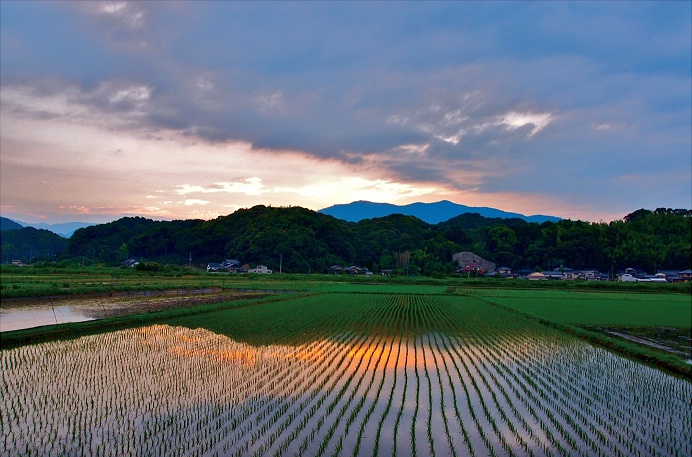Chapter 22. Chapter 22: Agriculture: Raising Crops
What are the advantages and disadvantages of sustainable farming, and what role will it play in helping us feed the world?

Guiding Question 22.5
What are the advantages and disadvantages of sustainable farming, and what role will it play in helping us feed the world?
Why You Should Care
Why isn't sustainable farming the rule instead of the exception? It comes down to money, demand, and inertia. There is a lot of profit to be made from industrial farming, but not all of it from selling the food. For example, the production of chemical fertilizers and pesticides is a huge business. In the United States, at least, governmental subsidies reward the industrial growing of crops more than sustainable production. It is normal for the production cost of crops to exceed the sale price and only subsidies allow farmers to profit from their efforts. This means that subsidies keep food prices lower than food costs. When sustainably grown food is sold at a more realistic price, it seems too expensive in comparison. As long as industrially grown food remains artificially cheaper than sustainably grown food, there will likely not be enough demand for sustainably grown food to make it mainstream.
There is also inertia and speculation in farming. Good growing seasons are always a gamble and farmers stick with methods that have worked for them in the past. It seems like a risky venture to most farmers to convert to less conventional, but more sustainable, methods. This is especially true because sustainable methods often have lower yields, regardless of the fact that the profit can be higher because of the reduced costs for fuel and chemicals.
Despite potentially lower yields, sustainable agriculture will likely be essential for avoiding food shortages in the future. As nonrenewable energy sources dwindle, industrial agriculture in developed countries will become less able to supply surplus food to the world. Most of the world's population is growing in developing countries, and, in many of those countries, farming is unsustainable in a way that is potentially irreversible. Staggering amounts of natural forests and other habitats are being lost in developing countries as people clear land to grow crops, livestock, and other products to support their families. Often, the degradation to the cleared land is extreme enough that it is unlikely the original natural ecosystem could recover if farming were abandoned. Even worse, the cleared land often becomes infertile within a few years, meaning that more land has to be cleared. Furthermore, the high costs and resources associated with industrial agriculture make it an impossibility for most farmers in developing countries. Sustainable farming methods could mean that families could have a stable source of food that doesn't come at the cost of environmental degradation. Combining sustainable agriculture with education, family planning, and social justice are all part of the path toward a sustainable world population.
Question 22.1
ojwZkvDgv5HJm5WOzz64yqkjX7pFyCdv8+XUZPALDuAionje2U4BrDuRpkjWrZXKL3XwmBaNKmBGlcQAIv7it3azK7SY7ahbhxa8VZ1CQ/lrcZ4yG7VWVvym5HFMrnNLEuMg2VPkx+RBo9OxPflYs/fjhkiQzEJbDaLKamuJrSv77vg6Zj+/YIGgU7z+1+vdPmyBJgZrUCzVWKy333EE3/UKro4gS3j4dM3XIvoM2PjHQO6l4b9ZIg==Question 22.2
X93XV+yEtyQBhny842tH/Z6eF31DtIkUrfMzojul5BkAKIgh/TXhw3LiZ+rsm5TXz7b0a405BF00BDKsxE2fHXYI0gRpXFhndP+nq5/ViG3huHAaVclSqepS646RYe7n4BXSYfeFEtNc06249pn4w7XqcEOsmXXGc/a1N7VvTMGdhP5OypX7Draio6eXtFcZw99XQzcB50Nya33p+VlmpLmyj8dF3jvC2AGNshOzCIia3OF0MQK27uU29k98KBhpZODblL6iWONPjzztGc2F4wWLfZWb5Yh+xfFO78wlXSQpHI89JU4ErvOAjcXw0NKXWD0PhCrWjiiI5hNLCMJ3ebFtWFlgPucvXINzqUSUO3yUYy+n7987YE7tVWiSa9DRyvGuEwROY+/Zp21KLEv9tnLKl2N/lH1DB8uyVAMAkMRt8cHllRj9rHw/YTWhLOd2DPBBSqVpn5OKMn/iHlX2RuLE9u4kndT1Yx0cmD3xdHg=Question 22.3
pb3/2LR6C8Hm/19VITrjRzmHMo4Cz41TqAfBim1suQ7U+lNTMiT7lWFBLu3OOhkMogcuAjLpympJKbHjIRx4/fWn3VrzX9XbE3f7i8+jEpgW24uE/LFIyu5ZQh5A4IBeQLEdEqhkkcC7I2jCOt3wXKyEFpT1X14w/p23y0fg268OSWbX27FNlNvCK0gwJUk1PtyLQEMTQYG25CFbTZGnsEoS0P4JQgr91v6B7TSPDC63x5isrGtPJKGrgHF9TJsbF6/EhPTgN0MB67liLmpakoWTHMvpJrRYJz0Xgq61BfVnW6uP7D883QXoAJQg55fNSemyDeDb5dzYTaxoQuestion 22.4
Pw65PaNxNPNahPaJCvWdA1iXGJnOuYiiX2yoJaayQFTEgljv6msH2PAKRdzfW82+otIYfSSoT9x2RJsXHxeI6zbxOGbimvDpLgxYSByitdq/KyFxGkwzB2rrSovPnfSScQTlgYH8RZYR8FfpCgyYNtF/WXYA389yxHpjp5wYhzwYy3KCZqs2hk9iQ/rOXS5n/sqRelpdkp7zT6In9b//zHuDrHYbCUtSro6l7YzkSWPqGyRZUhm8gD1a656Uy6Oaz3zuu/HqIv0z+dLFyWawzANksQxYDSXvLtaugMnfrLUTJDM3sV9xhLr+wQlaV6ilrwAcBmSLcNIK9hXOvce9TcXABKBt8WrJQuestion 22.5
a8OqFWZMK38VPcTVKXU/1wxjOa/dUR8dkPTe7Nl9zy9AJSjggs16UkAmdKxBtHPCvtkxNSw4sGHvyydH7icVZgFG4EySMTabNvXIdCRVBizd7xEXtPt1OH15fNlmzX0C3nnUPU5xeFc3XZHJECg153btL0uKh/Ea5vU6dMylShDoEA2sAUviw8F+isQJRAYvnLyvUkVAG6DoOZOnYslyP5AKyAM3Q/FyNJ+QEXokYzRPzjlGuTx/XmUohQHI2UKOR4C0K7MjErATjqsOvuq8mw==Question 22.6
DwS4we4hPcPqwVPyQtaLwGxoqI/ZMpvnpoC+eKYuG0wd0YfqDu9sbYR3n0FfljQW7FazFpT+aARPSnlD+kMwTZXCpkfxTMXpAwOYIuFq5/Sug71N2CoRytpAOnLdehL14h3/8kLpagMhnLwRXWQ/7QS/AzQDCfyzERacoheGesGApWOcHWWgSZSC1EI=An example of a possible answer is that developing countries are more likely to adopt sustainable agriculture because it is less expensive, is suited to local production, and conserves water, which, as a rule, is more likely to be in shorter supply in developing countries. Consumers in developing countries who are accustomed to unblemished, inexpensive produce are less likely to provide the market demand to support widespread adoption of sustainable agriculture.
Question
Short-Answer Questions
Suppose you are a farmer trying to make your farming operation greener. What are the disadvantages to each of the following, and what could you do to improve the sustainability of your farm in each circumstance?
6I2qFbakVsfEJ8YMFwHWaN26TdxPxvbgD3OtMGodPacKhu5yv1KHXQtDwtnuYPaF B86tPRY2fu2ARRJ42+gMDdUjYEJQMvyKU3pSt4ArvaTS47nzBKzjApZ0/Yo2RzZk iiYapKIcZV7vUgPW7VfRVd9UdmKiAbi6+K7pbCQ2vpa+68FxjMkH60ON+3Eh9ULGssTlf//UKuM= ktVMrH2s40Y8vRtQHSklMlgW5OzXFA93P2hl+fU/9d9KW8MSBO4giyb3MfRlWs6t 3Tm1bHCVuf0m+ZC29cYdKRqP6r8Ja2Lw4mS5MNX9YdQwO5t1lnaTOMcGhm8= n9EIu6qS6WMK0Cl5uJJdHu/b0250Fjfea5pbvPoeq17zI3d9xJdFZU8g74Hs+ZDI2SRhDA== ScuX76RpNRMCXgcmkIKQgTui7yCSn+5hWXtzeAeF15tJdGTZjzC4cXyp7z4shEt23ORRpLnbakKWihMJht0CpvF97tNkye/3Uk/x2E3f4YsMSEO23YA9wQ4KpvLTAQuaf1VN/WqFyG2xj5CMBu3MRyw3qM3LOAe+Rmh7qqDwEasCLh9Avf/+BXAl5hLGPFfrFjcSDfVVqMdax6r0fC2FKXQ4BMHXaRiCbgqDvSKKjB9B0tyUOjO3EcYjSU1Zq16vWnTuOJmPLEpMIqRI5brivQ==2) If the terrain is hilly and crops are planted in straight rows, there is increased chance of erosion. Solution: Contour farming is a better way to prevent erosion.
3) Synthetic fertilizers can run off into surface water, causing eutrophication, or seep into and contaminate ground water. The negative side of the increased plant growth is that the fertilized plants will remove other micronutrients from the soil at an unsustainable rate. Solution: Plant a nitrogen-fixing cover crop and combine that with reduced tillage farming for greater effect. (This is just one example of a solution.)
4) Current rates of crop irrigation are unsustainable. Solutions: Reduced tillage farming, cover crops, and choosing crops adapted for the local climate can all reduce water demands.
5) Pesticide use can also kill beneficial organisms, and its effect on the ecosystem is unknown. Solutions: Crop rotation and strip planting can help interrupt pest life cycles. There are many bio-controls available to combat pests, such as lady bugs, which are the natural predators of aphids, insects that suck the sap out of crops, decreasing their fitness.
6) Raising cattle on corn-based feed uses excess resources, creates eutrophying waste, and can lead to antibiotic-resistant bacteria. Solutions: Raising the cattle on grass reduces the chance of harmful antibiotic-resistant bacterial growth, the amount of food resources being being diverted from human consumption, the amounts of water and fossil fuels needed for operations, and the amount of waste (since it is used to fertilize the grass).
7) Question number seven has no suggested answer given in the manuscript.